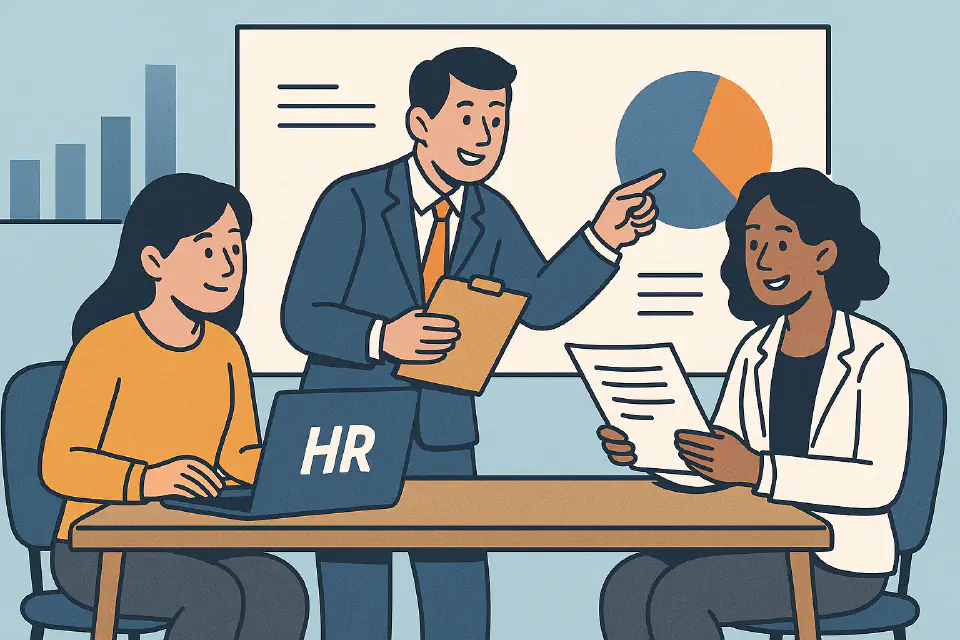
HR as a Strategic Partner
HR is often invited to 'sit at the table.' But what does it mean to be a true strategic partner? This page explores the theory, models, and real-life applications of HR’s role as a business ally and enabler of growth.
What Does It Mean for HR to Be a Strategic Partner?
Being a strategic partner means more than participating in leadership meetings. It means helping shape decisions that determine the company’s future.
In the words of Dave Ulrich, the father of the HRBP model:
“HR must become an architect of the organization’s capabilities — not just a supporter of its processes.”
At its best, HR as a strategic partner:
- Helps define business priorities through a people lens
- Uses data and insights to challenge assumptions
- Co-creates talent, culture, and capability strategies
Theoretical Foundations of HR as a Partner
1. Ulrich’s HR Business Partner Model
Introduced in the 1990s, this model reimagined HR as:
- Strategic Partner (aligning HR with strategy)
- Change Agent (leading transformation)
- Administrative Expert (efficiency and service delivery)
- Employee Champion (voice of the employee)
Today’s leading HRBPs often blend all these roles — with the strategic partner role as the anchor.
2. Strategic Human Resource Management (SHRM)
SHRM theory emphasizes that HR should:
- Contribute to organizational performance and competitiveness
- Integrate people strategy into business planning
- Be proactive, not reactive
Studies consistently link SHRM practices with higher profitability, innovation, and resilience.
3. Contemporary Critiques & Adaptations
While Ulrich’s model is still widely used, critics argue that:
- It often led to underpowered HRBP roles without decision rights
- It reinforced a service vs. partner split instead of true integration
Modern interpretations emphasize:
- HRBP as embedded, empowered, and data-driven
- Less about reporting lines, more about influence and accountability

Key Responsibilities of HR as a Strategic Partner
Being a strategic partner is not a title — it’s a set of behaviors and responsibilities:
🟢 Talent Strategy
- Identifying future capability needs
- Building succession and leadership pipelines
- Advising on make/buy decisions (hiring vs. upskilling)
🟢 Organization Design
- Advising on team structures, decision-making models, and workflows
- Supporting agility and cross-functional collaboration
🟢 Workforce Planning & Analytics
- Forecasting headcount and skills
- Modeling workforce costs and risks
- Using people data to influence strategy
🟢 Culture & Change Leadership
- Co-leading culture transformations
- Shaping behaviors that support strategy
- Acting as change agent during growth, crisis, or restructuring
🟢 Leadership Enablement
- Coaching senior leaders on people decisions
- Building leadership capability to execute strategy
How Strategic HRBP Works in Practice
Example 1: M&A Integration
HRBPs partner with finance and operations to:
- Assess cultural risks in target companies
- Design post-merger talent retention strategies
- Lead leadership alignment workshops
Result: Smoother integration, reduced talent flight.
Example 2: Entering a New Market
HRBP co-develops:
- Talent sourcing plan for local hiring
- Leadership assessment for local adaptability
- Reward strategy aligned with new market realities
Result: Accelerated market entry with strong local leadership.
Example 3: Business Unit Growth Planning
HRBP partners with Sales leadership:
- Models workforce needs for next 12 months
- Identifies skills gaps and L&D priorities
- Advises on hybrid team models and manager capability gaps
Result: Sales growth supported by people strategy — not hindered by it.
Critical Success Factors for Strategic HR
| Success Factor | Why It Matters |
|---|---|
| Business Acumen | HR must speak the language of revenue, cost, and growth |
| Data Fluency | Data-backed insights earn trust and drive decisions |
| Proactivity | Waiting for requests is reactive, partners anticipate needs |
| Influence & Credibility | Without trust, HR will not be consulted in key decisions |
| Decision Rights | HR needs authority, not just opinions |
Common Mistakes to Avoid
Other pitfalls include:
- HRBP as messenger between teams (instead of integrator)
- Over-focusing on tactical requests (e.g. conflict resolution)
- Lack of preparation to challenge leadership thinking
Best Practice: Building a Strategic HR Partnership
Empower HRBPs with:
- Direct access to leadership
- Clear KPIs linked to business goals
- Authority to challenge and advise
Final Thought
Being a strategic partner is not about being at the table. It’s about helping set the agenda. The best HR teams are not invited — they are essential.
To get there, HR must:
- Invest in its own capabilities
- Build credibility through insights and action
- Shape strategy through the lens of people and culture